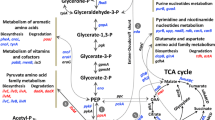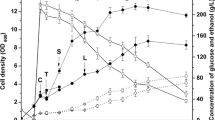Abstract
Microorganisms respond to environmental changes by reprogramming their metabolism primarily through altered patterns of gene expression. DNA microarrays provide a tool for exploiting microorganisms as living sensors of their environment. The potential of DNA microarrays to reflect availability of nutrient components during fermentations on complex media was examined by monitoring global gene expression throughout batch cultivation of Escherichia coli MG1655 on Luria–Bertani (LB) medium. Gene expression profiles group into pathways that clearly demonstrate the metabolic changes occurring in the course of fermentation. Functional analysis of the gene expression related to metabolism of sugars, alcohols, and organic acids revealed that E. coli growing on LB medium switches from a sequential mode of substrate utilization to the simultaneous one in the course of the growth. Maltose and maltodextrins are the first of these substrates to support growth. Utilization of these nutrients associated with the highest growth rate of the culture was followed by simultaneous induction of enzymes involved in assimilation of a large group of other carbon sources including d-mannose, melibiose, d-galactose, l-fucose, l-rhamnose, d-mannitol, amino sugars, trehalose, l-arabinose, glycerol, and lactate. Availability of these nutrients to the cells was monitored by induction of corresponding transport and/or catabolic systems specific for each of the compounds.





Similar content being viewed by others
References
Alexander DM, Damerau K, St. John AC (1993) Carbohydrate uptake genes in Escherichia coli are induced by carbon starvation. Curr Microbiol 27:335–340
Baev MV, Baev D, Jancso Radek A, Campbell JW (2006a) Growth of Escherichia coli MG1655 on LB medium: monitoring utilization of amino acids, peptides, and nucleotides with transcriptional microarrays. Appl Microbiol Biotechnol DOI 10.1007/s00253-005-0310-5
Baev MV, Baev D, Jancso Radek A, Campbell JW (2006b) Growth of Escherichia coli MG1655 on LB medium: determining metabolic strategy with transcriptional microarrays. Appl Microbiol Biotechnol DOI 10.1007/s00253-006-0392-8
Boos W, Shuman H (1998) Maltose/maltodextrin system of Escherichia coli: transport, metabolism, and regulation. Microbiol Mol Biol Rev 62:204–229
Boos W, Ehmann U, Bremer E, Middendorf A, Postma P (1987) Trehalase of Escherichia coli. Mapping and cloning of its structural gene and identification of the enzyme as a periplasmic protein induced under high osmolarity growth conditions. J Biol Chem 262:13208–13212
Boos W, Ehmann U, Forkl H, Klein W, Rimmele M, Postma P (1990) Trehalose transport and metabolism in Escherichia coli. J Bacteriol 172:3450–3461
Chang DE, Smalley DJ, Conway T (2002) Gene expression profiling of Escherichia coli growth transitions: an expanded stringent response model. Mol Microbiol 45:289–306
Cox WG, Singer VL (2004) Fluorescent DNA hybridization probe preparation using amine modification and reactive dye coupling. Biotechniques 36:114–122
De la Broise D, Dauer G, Gildberg A, Geurard F (1998) Evidence of positive effect of peptone hydrolysis rate on Escherichia coli culture kinetics. J Mar Biotechnol 6:111–115
DeRisi JL, Iyer VR, Brown PO (1997) Exploring the metabolic and genetic control of gene expression on a genomic scale. Science 278:680–686
Diehl F, Grahemann S, Beier M, Hoheisel JD (2001) Manufacturing DNA microarrays at high spot homogeneity and reduced background signal. Nucleic Acids Res 29:e38
Egli T (1995) The ecological and physiological significance of the growth of heterotrophic microorganisms with mixtures of substrates. Adv Microb Ecol 14:305–386
Ferguson GP, Tötemeyer S, MacLean MJ, Booth IR (1998) Methylglyoxal production in bacteria: suicide or survival? Arch Microbiol 170:209–219
Hanko VP, Rohrer JS (2000) Determination of carbohydrates, sugar alcohols, and glycols in cell cultures and fermentation broths using high-performance anion-exchange chromatography with pulsed amperometric detection. Anal Biochem 283:192–199
Hanko VP, Rohrer JS (2004) Determination of amino acids in cell culture and fermentation broth media using anion-exchange chromatography with integrated pulsed amperometric detection. Anal Biochem 324:29–38
Hedge P, Qi R, Abernathy K, Gay G, Dharap S, Gaspard R, Hughes GE, Snesrud E, Lee N, Quackenbush J (2000) A concise guide to cDNA microarray analysis. Biotechniques 29:548–562
Iding K, Buntemeyer H, Gudermann F, Deutschmann SM, Kionka C, Lehmann J (2001) An automatic system for the assessment of complex medium additives under cultivation conditions. Biotechnol Bioeng 73:442–448
Jensen KF (1993) The Escherichia coli “wild types” W3110 and MG1655 have an rph frameshift mutation that leads to pyrimidine starvation due to low pyrE expression levels. J Bacteriol 175:3401–3407
Kasprow RP, Lange AJ, Kirwan DJ (1998) Correlation of fermentation yield with yeast extract composition as characterized by near-infrared spectroscopy. Biotechnol Prog 14:318–325
Kerr MK (2003) Experimental design to make the most of microarray studies. In: Brownstein MJ, Khodursky AB (eds) Functional genomics: methods and protocols, vol. 224. Humana Press, Totawa NJ, pp 137–147
Khodursky AB, Bernstein JA, Peter BJ, Rhodius V, Wendisch F, Zimmer DP (2003) Escherichia coli spotted double-strand DNA microarrays: RNA extraction, labeling, hybridization, quality control and data management. In: Brownstein MJ, Khodursky AB (eds) Functional genomics: methods and protocols, vol 224. Humana Press, Totawa NJ, pp 61–78
Kovarova-Kovar K, Egli T (1998) Growth kinetics of suspended microbial cells: from single-substrate-controlled growth to mixed-substrate kinetics. Microbiol Mol Biol Rev 62:646–666
LaRossa RA, Van Dyk TK (2000) Application of stress responses for environmental monitoring and molecular toxicology. In: Storz G, Hengge-Aronis R (eds) Bacterial stress responses. ASM Press, Washington DC, pp 453–468
Lee JM, Zhang S, Saha S, Santa Anna S, Jiang C, Perkins J (2001) RNA expression analysis using an antisense Bacillus subtilis genome array. J Bacteriol 183:7371–7380
Lendenmann U, Egli T (1995) Is Escherichia coli growing in glucose-limited chemostat culture able to utilize other sugars without lag? Microbiology 141:71–78
Lendenmann U, Snozzi M, Egli T (1996) Kinetics of the simultaneous utilization of sugar mixtures by Escherichia coli in continuous culture. Appl Environ Microbiol 62:1493–1499
Lendenmann U, Snozzi M, Egli T (2000) Growth kinetics of Escherichia coli with galactose and several other sugars in carbon-limited chemostat culture. Can J Microbiol 46:72–80
Lin ECC (1996) Dissimilatory pathways for sugars, polyols and carbohydrates. In: Neidhardt FC, Curtis R III, Ingraham JL, Lin ECC, Low KB, Magasanik B, Reznikoff WS, Riley M, Schaschter M, Umbarger HE (eds) Escherichia coli and Salmonella: cellular and molecular biology, 2nd edn. ASM Press, Washington DC, pp 307–342
Mader U, Homuth G, Scharf C, Buttner K, Bode R, Hecker M (2002) Transcriptome and proteome analysis of Bacillus subtilis gene expression modulated by amino acid availability. J Bacteriol 184:4288–4295
Miller JH (1972) Experiments in molecular genetics. Cold Spring Harbor Laboratory, Cold Spring Harbor
Miller T, Churchill BW (1986) Substrates for large-scale fermentations. In: Demain AL, Solomon NA (eds), Manual of industrial microbiology and biotechnology. ASM Press, Washington DC, pp 122–136
Payne JW, Smith MW (1994) Peptide transport by micro-organisms. Adv Microb Physiol 36:1–80
Polen T, Rittmann D, Wendisch VF, Sahm H (2003) DNA microarray analyses of the long-term adaptive response of Escherichia coli to acetate and propionate. Appl Environ Microbiol 69:1759–1774
Potvin J, Fonchy E, Conway J, Champagne CP (1997) An automatic turbidimetric method to screen yeast extracts as fermentation nutrient ingredient. J Microbiol Methods 29:153–160
Reissbrodt R, Beer W, Müller R, Claus H (1995) Characterization of casein peptones by HPLC profiles and microbiological growth parameters. Acta Biotechnol 15:223–232
Rimmele M, Boos W (1994) Trehalose-6-phosphate hydrolase of Escherichia coli. J Bacteriol 176:5654–5664
Rose AH, Vijayalakshmi G (1993) Baker’s yeasts. In: Rose AH, Harrison JS (eds) The yeasts, vol 4, 2nd edn. Academic, San Diego, CA, pp 357–397
Saksinchai S, Suphantharika M, Verduyn C (2001) Application of Bacillus thuringiensis sbsp. kurstaki: a physiological study. World J Microbiol Biotechnol 17:307–316
Su TZ, Schweizer HP, Oxender DL (1991) Carbon-starvation induction of the ugp operon, encoding the binding-protein dependent sn-glycerol-3-phosphate transport system in Escherichia coli. Mol Gen Genet 230:28–32
Tao H, Bausch C, Richmond C, Blattner FR, Conway T (1999) Functional genomics: expression analysis of Escherichia coli growing on minimal and rich media. J Bacteriol 181:6425–6440
VanDusen WJ, Fu J, Bailey FJ, Burke CJ, Herber WK, George HA (1997) Adenine quantitation in yeast extracts and fermentation media and its relationship to protein expression and cell growth in adenine auxotrophs of Saccharomyces cerevisiae. Biotechnol Prog 13:1–7
Zhang J, Reddy J, Buckland B, Greasham R (2003) Toward consistent and productive complex media for industrial fermentations: studies on yeast extract for a recombinant yeast fermentation process. Biotechnol Bioeng 82:640–652
Author information
Authors and Affiliations
Corresponding author
Rights and permissions
About this article
Cite this article
Baev, M.V., Baev, D., Radek, A.J. et al. Growth of Escherichia coli MG1655 on LB medium: monitoring utilization of sugars, alcohols, and organic acids with transcriptional microarrays. Appl Microbiol Biotechnol 71, 310–316 (2006). https://doi.org/10.1007/s00253-006-0317-6
Received:
Revised:
Accepted:
Published:
Issue Date:
DOI: https://doi.org/10.1007/s00253-006-0317-6




